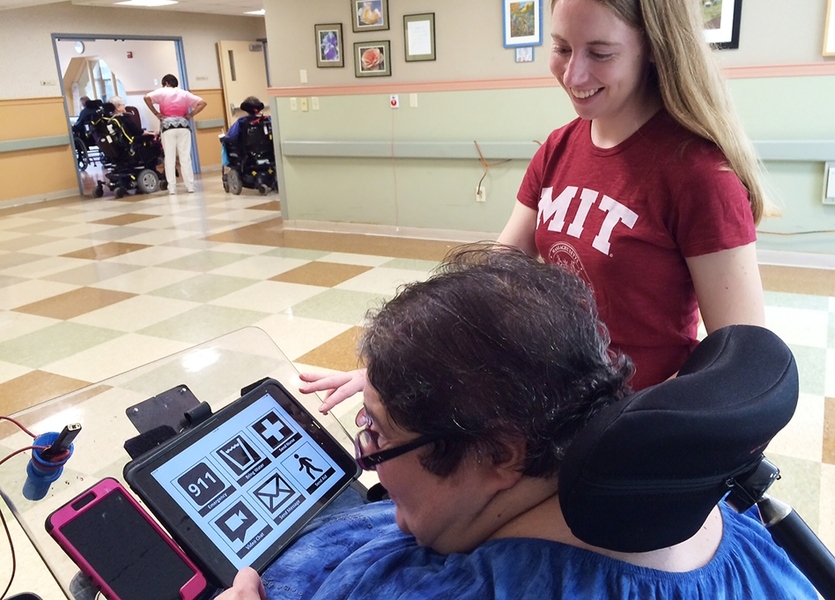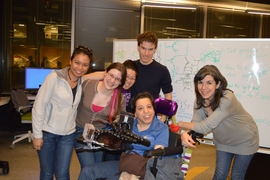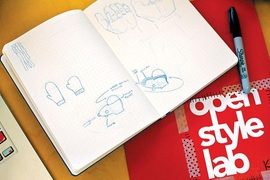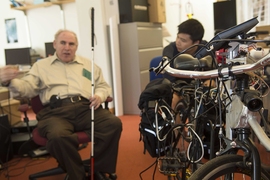"Far and away the best prize that life has to offer is the chance to work hard at work worth doing," Theodore Roosevelt once said in a speech in 1903. MIT senior in computer science Beth Hadley takes these words to heart. In the past academic year she has been a pivotal force behind InstaAid, an iPad application that enables residents at The Boston Home (TBH) to access assistance from any area of the facility, thus increasing their safety and quality of life.
During the fall of 2014, in the course 6.811 (Principles and Practices in Assistive Technologies, or PPAT), Hadley and her classmates, senior Laura D'Aquila and junior Tanya Talkar, formed a team with Margaret Marie, a TBH resident, to design an application that transformed the nurse call system at the home. "Margaret has provided incredible vision and direction for our project; she not only provided concrete ideas but also inspired us with her desire to help others. Ultimately, she instilled in us the drive and dedication to truly make an impact," Hadley says.
For many residents of the home, calling for help is not a simple task. Most residents have limited mobility due to conditions such as multiple sclerosis (MS) or amyotrophic lateral sclerosis (ALS), making it difficult, and many times impossible, to reach the help button wired to the wall. Many residents, however, already use iPads attached to their wheelchairs. "The home is extremely innovative when it comes to technology, and yet their nurse call system hadn't been improved in years," Hadley explains. "We aimed to change that."
“I had been thinking for a while about how antiquated our nurse call system was, and how it is tied to a single place in our room, which makes it so ineffective, especially when people are not in their bed. And we're an active group, so often people are not in their bed, so people need to be able to access help when they're out and about,” Marie says.
While the first iteration of the application was developed during the PPAT class, Hadley turned it into her senior thesis project and continued to improve it. She tested and revised several prototypes and incorporated feedback from TBH residents and staff throughout, turning an experimental product into a robust and sustainable call system downloadable from the Apple App Store.
The application garnered attention at the recent undergraduate research conference EECScon, where Hadley won the “Crowd Favorite Poster Presentation” for creating an accessible call system.
Technology for people
“The InstaAid Nurse Call project represents the myriad of ways that technology can be used to enhance the lives of people with disabilities,” says Don Fredette, adaptive technology specialist at The Boston Home. The application transforms the process of providing help to residents. With two interfaces, one for the resident, and one for the nurse, users can request water, aid, or signal an absolute emergency at the touch of a button, whether they are in their room, in the garden, or even away from the home’s premises. Users can also send custom text messages or initiate a video chat, making the platform usable in a variety of ways by people of all abilities and needs. For instance, residents unable to speak can communicate their requests by typing the message on their iPad. The custom notification helps nurses identify real emergencies and dispatch the right personnel for each call.
“InstaAid is now the preferred communication for residents to reach assistance in any location on our campus," Marva Serotkin, CEO of The Boston Home, says. Starting in December, two residents, including Marie, used the application and provided feedback. Since the app has been officially launched this spring, many iPad users at the home have adopted the new technology. "Communication between caregivers and residents can be a challenge,” Fredette says. “The application gives residents piece of mind that anywhere where they have their iPad with them, they can make their needs known."
"For me, this project helped illuminate the vast difference between developing a prototype, and actually introducing a new piece of technology to a community," Hadley explains. InstaAid is not just another research endeavor; rather, it is about working with people and designing a solution tailored to their needs. “It’s this kind of project that reminds me why I love technology so much, and why I love to share my technical skills with others,” Hadley says.
The application can be downloaded and deployed beyond The Boston Home, at other assistive care facilities and hospitals. The code is universal and open source, and Hadley is hopeful that this project will inspire similar efforts in other communities. InstaAid is one of the first mainstream mobile communication technology that meets the dynamic communications needs of differently-abled individuals — the interface is designed to accommodate for visual, motor, and cognitive challenges.
Hadley was awarded a LEAP grant from the MIT Public Service Center to fund the purchase of the first iPad installed at the nurses’ station this winter. Since then, TBH has purchased another for their second floor station. The iPad is used daily by nurses to respond to resident’s requests.
“The InstaAid app has already been instrumental in providing emergency communication for at least one Boston Home resident, who found herself trapped in her power wheelchair in a closed area of an off-site building," says Alexander Burnham, director of rehabilitation services at TBH. The building had an active WiFi signal, and the resident was able to activate InstaAid, initiate a Facetime chat, and speak directly with a staff member, who sent immediate assistance.
Stronger community through assistive technology and co-design at MIT
Assistive technology has a years-long history at MIT, starting when MIT’s Computer Science and Artificial Intelligence Laboratory (CSAIL) and the Age Lab worked with TBH on a robotic wheelchair project led by the late professor Seth Teller. A little over four years ago, Teller founded course 6.811 and developed partnerships with a number of local organizations that serve people with disabilities. In this class, students pair up with assistive technology users. The process is focused on co-design, empowering users to participate fully and make decisions. Students and users learn from each other and create a custom accessible product that improves the quality of life of the user. “I can't think of a better example than Beth, Laura, and Tanya's team — from the start of the course last semester they got to know and incorporate Margaret's goals and ideas," says William Li, who co-taught the PPAT course last fall. “Empowering the end user isn't just a matter of principle — as Beth and her team have shown, it leads to successful assistive technology. I believe strongly in PPAT's model of service learning through design and engineering, and I would like to see it proliferate across the country.”
William Li was recently awarded the Priscilla King Gray Award for Public Service for his work in assistive technology, leadership, and commitment to others. Li is also the president of the MIT Assistive Technology Club and a PhD candidate in computer science, Course 6.
MIT alumna Grace Teo, who co-taught the PPAT class and served as an advisor for the InstaAid project, is one of the founders of Open Style Lab. The lab runs a workshop that merges fashion design, engineering, and occupational therapy to create stylish clothing for people of all abilities.
These partnerships enable MIT to develop “deep, meaningful connections with people and organizations in our neighborhood through the best we have to offer: our students and our desire to solve problems, no matter how challenging they may seem,” Li says.
Referring to MIT's collaboration with TBH, Fredette added, "This partnership allows TBH to be on the cutting edge of assistive technology and it allows us to work with folks who develop new prototypes and be trendsetters. We need technology to improve the quality of life for our residents.”
Marie, who helped design and test InstaAid, says: “I'm a person who has lots of ideas, but I often can't put them into practice without help ... sometimes I can, but usually I need some help. But with [the MIT team], I felt I could be an ideas person because I had a team who could implement the idea. It gave me a lot of confidence in being able to think something through and be able to implement it. It's great to feel like you are part of a team even though you physically can't do something — it's wonderful.”











